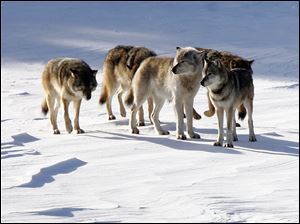U.P. hunters should consider refraining from crying wolf
 Gray wolves often get the blame for the small size of deer herds in the Upper Peninsula, but the predators rank behind coyotes, bobcats, and man as killers of deer.
Gray wolves often get the blame for the small size of deer herds in the Upper Peninsula, but the predators rank behind coyotes, bobcats, and man as killers of deer.A recent study of the white-tailed deer population in the 16,000 square miles of the Upper Peninsula revealed some preliminary but surprising data about wolves and their influence on the size of the deer herd. It also shed some light on another culprit who deserves some consideration when the top predators in the U.P. are lined up.
Survey says ... coyotes killed a lot more Upper Peninsula deer than wolves did, at least during the first three-year phase of a study that will take at least nine years total to complete. Wolves were a distant fourth on the list of the most notorious deer hunters, behind coyotes, bobcats, and man.
The overall study is looking at the U.P. and the impact of predators and winter weather on the deer population. The first part of the review examined a large section of the Upper Peninsula that has some agriculture, wood lots, and state forest area and is designated as a "low snowfall zone."
The second phase of the study won't begin until next winter and will look at a "moderate snowfall zone," and the final phase is slated to examine a heavy snowfall area. The nature of the study area and the amount of snowfall it receives likely have a lot to do with which predator will have the biggest impact on the deer population, biologists say.
"Winter weather affects deer big time," said Dean Beyer, a wildlife researcher with Michigan's Department of Natural Resources. A severe winter can wipe out a third of the deer herd in the Upper Peninsula, Beyer said, and two straight years of extremely harsh winters in the early 1990s delivered a substantial hit to the whitetail population and it has yet to fully recover.
livestock gutpiles attract scavengers as well as carnivores
The Upper Peninsula, an expansive, remote tract of land, comprises about 30 percent of the land area of Michigan, but is home to only three percent of the population of the state. Recent estimates put the deer population in Michigan's U.P. at about 270,000, while the gray wolf population is just under 700.
Beyer said numerous factors could possibly have led to the results of the initial phase of the survey, which put coyotes at the top of the predator list. The studied zone in the U.P. had several livestock carcass dump sites that were frequented by the two resident wolf packs in the area. Feeding on dead livestock likely kept the wolves from constantly pursuing deer.
"Wolves were visiting those areas quite frequently, but we expect to see something very different in the other study areas, since no livestock are present there," he said.
Beyer said recent similar surveys in Wisconsin produced drastically different results in the two dissimilar studied areas. "The relationships we find in one area quite possibly won't apply across the board," he said.
In the completed U.P. study, about 150 fawns in the low snowfall zone were fitted with GPS collars that provided data on the location of the fawns at 15-minute intervals. Predators, including wolves, bears and coyotes, were also fitted with tracking collars. In the first three years of the study, 80 of the fawns died, with predators taking about 60 of the deer.
When a predator spent a significant amount of time in one area, it was assumed it was either resting or working on a kill. Biologists with dogs then searched the area to determine if a kill had taken place.
Beyer said bobcats proved to be very effective hunters and had a high kill rate with U.P. deer, but bobcats are comparatively low in number. There are also "a lot more" coyotes than wolves in the Upper Peninsula, Beyer said.
Beyer wants the big picture before making any major assessments. He cautioned against drawing too many sweeping conclusions on the role of any of the primary predators in limiting the size of the whitetail herd in the U.P. with just the initial study zone numbers to review.
"It's not that simple," Beyer said. "We'll be looking at different habitat and different predator-prey ratios in the other study areas."
Beyer said from an evolutionary standpoint, predators would not be inclined to wipe out their prey and thus put their own existence in peril.
Wolves are native to Michigan and were once present in all 83 of its counties, but by about 1935, wolves were essentially eliminated from the Lower Peninsula. When a state-paid bounty on wolves was finally removed in 1960, wolves were nearly gone from the Upper Peninsula, as well.
When the gray wolf was added to the list of endangered species in 1973, Michigan's wolf population in the U.P. was close to being wiped out. It has recovered to the healthy numbers of today, but Beyer said the stigma of the ages persists.
"There is still something of a bias present with some folks when it comes to wolves," he said.












No comments:
Post a Comment